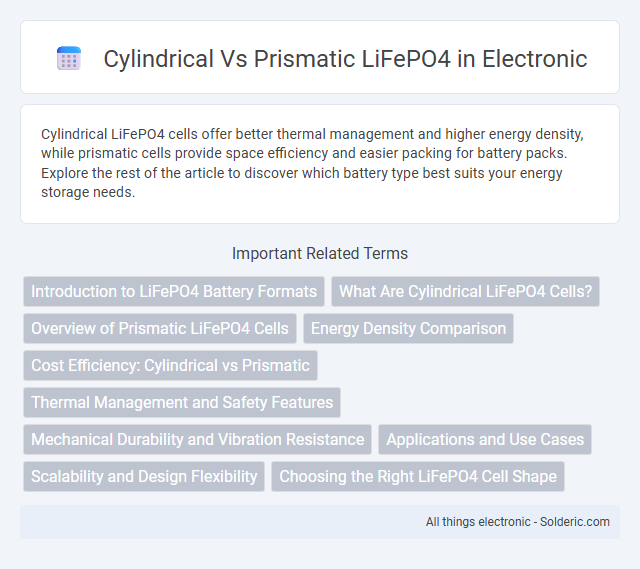Cylindrical LiFePO4 cells offer better thermal management and higher energy density, while prismatic cells provide space efficiency and easier packing for battery packs. Explore the rest of the article to discover which battery type best suits your energy storage needs.
Comparison Table
| Feature | Cylindrical LiFePO4 | Prismatic LiFePO4 |
|---|---|---|
| Shape | Round, tubular | Rectangular, flat |
| Energy Density | Moderate (90-110 Wh/kg) | Higher (110-130 Wh/kg) |
| Thermal Management | Excellent heat dissipation | Poorer heat dissipation |
| Durability | Robust, less prone to swelling | More prone to swelling and deformation |
| Cycle Life | Up to 3000+ cycles | Up to 2500-3000 cycles |
| Cost | Generally lower | Generally higher |
| Applications | Power tools, electric vehicles, energy storage | Electric vehicles, stationary energy storage, UPS |
| Manufacturing Complexity | Simple assembly | More complex, requires casing |
| Weight | Heavier per volume | Lighter per volume |
Introduction to LiFePO4 Battery Formats
LiFePO4 batteries come in two primary formats: cylindrical and prismatic, each tailored for specific applications. Cylindrical cells offer high energy density and robust structural integrity, making them ideal for power tools and electric vehicles. Prismatic cells provide better space efficiency and thermal management, favored in large-scale energy storage systems and electric mobility solutions.
What Are Cylindrical LiFePO4 Cells?
Cylindrical LiFePO4 cells are lithium iron phosphate batteries shaped in a round, tube-like design, commonly with dimensions such as 18650 or 21700. These cells offer high energy density, excellent thermal management, and robust mechanical stability, making them ideal for electric vehicles and portable electronics. Their uniform shape allows efficient packing in battery packs, improving heat dissipation and overall safety compared to prismatic cells.
Overview of Prismatic LiFePO4 Cells
Prismatic LiFePO4 cells offer a compact, space-efficient design with high energy density suitable for electric vehicles and energy storage systems. Their rectangular shape allows for better packing and heat dissipation compared to cylindrical cells, enhancing thermal management and safety. These cells are widely used in applications requiring stable voltage output and long cycle life, benefiting from the LiFePO4 chemistry's inherent stability and reliability.
Energy Density Comparison
Cylindrical LiFePO4 cells typically exhibit an energy density of around 100-110 Wh/kg, while prismatic cells offer slightly lower values, generally in the 90-105 Wh/kg range. The cylindrical form factor allows better heat dissipation and structural integrity, contributing to more efficient energy packaging. Prismatic cells prioritize space utilization and are favored in applications requiring compact designs despite their modestly reduced energy density.
Cost Efficiency: Cylindrical vs Prismatic
Cylindrical LiFePO4 batteries generally offer higher cost efficiency due to their standardized sizes and mass production, which reduces manufacturing expenses. Prismatic LiFePO4 cells, while providing better space utilization and design flexibility, often come with higher production costs and increased packaging complexity. Your choice between cylindrical and prismatic LiFePO4 cells should consider the balance between upfront cost savings and long-term application-specific performance benefits.
Thermal Management and Safety Features
Cylindrical LiFePO4 cells offer superior thermal management due to their high surface area, promoting efficient heat dissipation and reducing hotspot formation during high discharge rates. Prismatic LiFePO4 cells, while space-efficient, often require enhanced cooling systems to maintain thermal stability and prevent thermal runaway. Your battery system's safety features improve significantly when choosing cylindrical cells, as their design inherently supports better heat management and mitigates overheating risks.
Mechanical Durability and Vibration Resistance
Cylindrical LiFePO4 batteries exhibit superior mechanical durability due to their robust metal casing, which effectively resists impacts and external stresses, making them ideal for applications with frequent vibrations. Prismatic LiFePO4 cells, while offering a compact and space-efficient design, typically have thinner casings that may be more susceptible to deformation under mechanical strain, leading to lower vibration resistance. The cylindrical form factor's uniform shape contributes to better internal pressure distribution, enhancing long-term reliability in high-vibration environments.
Applications and Use Cases
Cylindrical LiFePO4 batteries are widely used in power tools, electric bikes, and portable electronics due to their high energy density and ease of thermal management. Prismatic LiFePO4 cells are preferred in electric vehicles, energy storage systems, and large-scale applications because of their compact design and efficient space utilization. Both types provide superior safety and long cycle life, with cylindrical cells excelling in high-drain scenarios and prismatic cells optimized for volumetric energy efficiency.
Scalability and Design Flexibility
Cylindrical LiFePO4 cells offer enhanced scalability due to their standardized sizes, enabling easy parallel and series configurations for various energy storage applications. Prismatic LiFePO4 cells provide superior design flexibility, allowing manufacturers to optimize shape and volume for compact battery packs, particularly in electric vehicles and portable devices. Both cell types balance energy density and thermal management, with prismatic cells often preferred for space-efficient designs and cylindrical cells for modular expansion.
Choosing the Right LiFePO4 Cell Shape
Selecting the right LiFePO4 cell shape depends on application-specific requirements such as energy density, thermal management, and mechanical stability. Cylindrical LiFePO4 cells typically offer higher structural integrity and better heat dissipation, making them ideal for high-drain applications and electric vehicles. Prismatic cells provide a more space-efficient design with higher volumetric energy density, suited for compact devices and stationary energy storage systems.
Cylindrical vs Prismatic LiFePO4 Infographic

 solderic.com
solderic.com